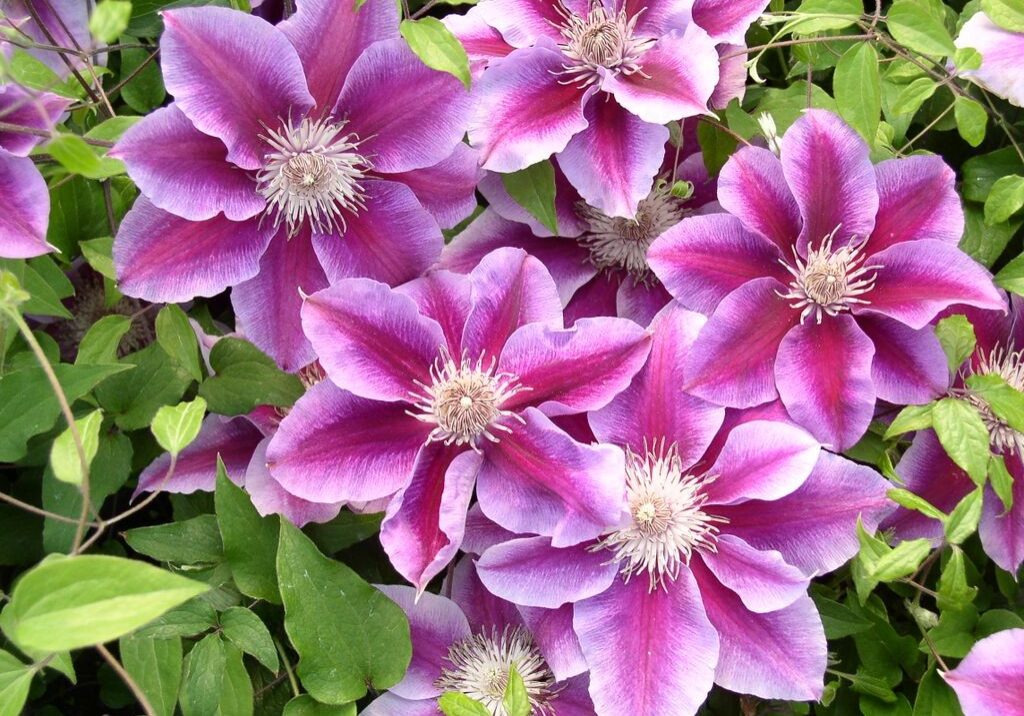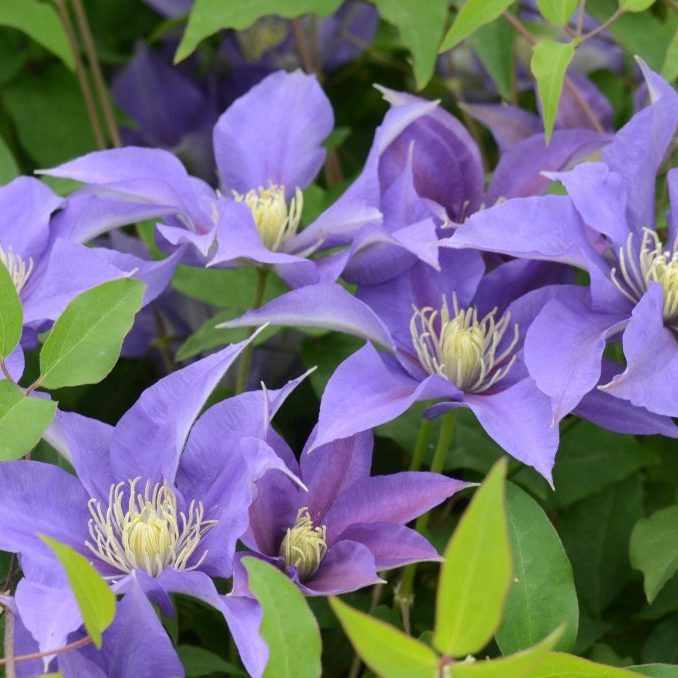5-6 Hours of Sunlight
Clematis Culture
The best time to plant clematis would be Spring, Summer, or early Autumn in a location of 5-6 hours of sunlight.
Loosen the soil to a depth of 2 feet. Mix this soil with peat and sand. Carefully set your clematis plant in the hole so the crown is 1 inch below the soil level when the plant was in the pot. You will cover up one or two sets of leaves. You do not need to remove the leaves. Shoots will appear from under the ground from these nodes that are covered with soil, creating a bushy plant from the base. Also if the plant is ever broken off at ground level it will not be lost as it will shoot up from under the ground.
The Roots Run Deep
Clematis roots are long and run deep and like it cool and damp, but not soggy. A good idea is to plant annuals around the base of the clematis, plant a low-growing shrub to shade the roots, or mulch the ground around the base of the clematis plant to help keep the soil and roots cool.
Stake the plant and if possible wrap a piece of screen loosely around this to prevent animals from breaking or eating off the stem for the first year. The stake should be placed toward the trellis, to train the plant to its permanent support.
Keep Your Clematis Well Watered
Keep your clematis well watered, do not let it dry out. In years to come, always soak well once a week in dry weather. Feed twice a year with a balanced granular fertilizer, or a good water-soluble fertilizer that will get to the plant much quicker.
Prune your clematis the first spring after planting to 10 - 12 inches. This is very important to get your plant off to low branching and heavier flowering over the whole clematis vine.
Apply mulch around the base of your clematis through the winter dormant months. With proper care your clematis plant will give you much enjoyment for many years!
The Many Ways Clematis Can Be Used
- Grow on all types of fences, and even stone walls.
- Train to grow up a tree trunk, tree stumps and rock piles.
- Use as a ground cover.
- Frame around porches and other entrances.
- Grow up unsightly utility and light poles.
- Screen unwanted views.
- Grow along with a climbing rose.
- Grow through shrubs of all kinds.
- Grow clematis in a container on a trellis or other support.
- Grow as a cut flower or float flowers in a bowl.
- Clematis can be planted in the garden most any month the soil can be worked up.
- An established clematis will live for years with normal care.
Retail Conditions of Sale
All varieties are offered, subject to availability. Every effort is made to see that all our plants are of the highest quality when leaving the nursery.
However, neglect, poor planting conditions, adverse weather, and animal damage can lead to plants failing. We can't consider complaints made more than 28 days after purchase.
Within this period, and at our discretion, we would generally replace plants free of charge if they fail within 14 days of purchase or at half price if they fail between 14 and 28 days.
Photos are required for our review of the credit request. The placing of an order or the purchase of a plant implies the acceptance of these terms.
Pruning Techniques
1
This group of clematis produce their flowers directly from old stems and, therefore, pruning must not be done until right after all flowering has been completed. Prune this group by removing all dead and weak stems immediately after flowering. Large established plants over 15 feet are normally not pruned, especially if they are growing in trees. All stems at this time should be tied into position on their trellis or other host. Also, if the Clematis has outgrown their space the correct and only time to prune to size is right after flowering is done. After pruning new growth will b
2
In this group, all the first flowering comes from last season's ripened stems. In early Spring watch for swelling leaf buds beginning to show. Cut all dead material off above these swelling buds. Be sure all growth is tied to trellis at this time. Do not tie too tightly, so growth can begin and not be hampered by tying too tight or cracking these stems.
3
This group blooms later and from new growth. This group should be pruned in February or March as new leaf buds begin to show low on the plant. All dead material above these buds should be removed at this time. Clean out any old foliage or foliage with mildew at this time also.


